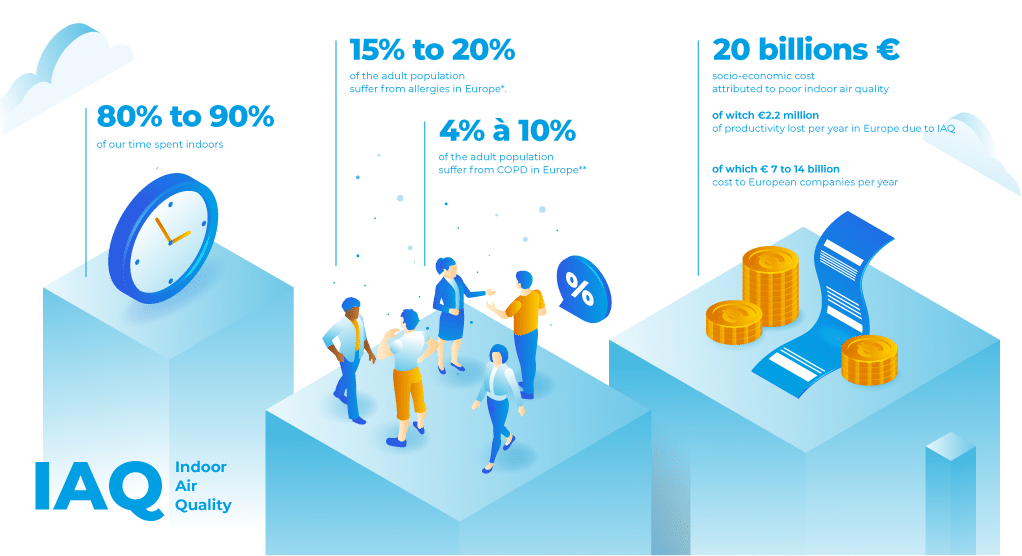The challenges of indoor air quality
The relationship between Indoor (and Outdoor) Air Quality, HVAC (Heating, Ventilation and Air Conditioning) systems and occupant health is very closely linked. Indoor air quality is at the heart of every debate, given thatwe spend almost 90% of our time in enclosed spaces.
This invisible pollution is a major environmental health problem. Poor air quality can cause headaches, fatigue, concentration problems, skin rashes and irritation of the eyes, nose, throat and lungs.

Corporate Social Responsibility (CSR) objectives
-
Health, comfort and well-being of occupants
Quality of life and air quality are intimately linked. Headaches, dryness, tingling and nasal congestion are the immediate effects of poor indoor air quality on occupants.
-
Preventing risks
Many chronic illnesses (COPD, asthma, allergies) are directly attributable to long-term inappropriate air environments.
An economic challenge
-
Increase performance and productivity & reduce absenteeism
Drowsiness, sore throats, rhinitis… Whether it has an impact on individual performance or absenteeism, poor air quality is a factor that limits a company’s productivity.
-
Three approaches to solving a health problem
There are three approaches to solving a health problem: Reactive, Preventive and Predictive.
- The Reactive Approach benefits from experience for an optimal response
- The Preventive Approach has a generally lower health and economic cost.
- The Predictive Approach attempts to optimise the response by taking the best of the other two. Predictive maintenance of air conditioning networks, for example, is a new source of optimisation.
A Health Issue
-
An aggravating factor
For several years now, the WHO has recognised poor air quality as a major aggravating factor in a number of diseases (stroke, heart disease, respiratory ailments, etc.). 7 million premature deaths are attributable in part to poor air quality.
-
Chronic, systemic exposure
According to the WHO, 91% of the world’s population lives or frequents places where pollutant levels exceed guide values. Indoor air pollution is just as much a concern as the smog in major cities.
-
The most vulnerable are the hardest hit
Almost half of all pneumonia-related deaths among children are directly attributable to poor air quality, especially soot and kitchen fumes. The elderly and people with respiratory difficulties are also more exposed to the consequences of poor air quality.
La QAI, les premiers pas de la réglementation en France

Air quality is an international issue. World Health Organisation (WHO) guidelines on air quality assess the effects of atmospheric pollution and set threshold values above which it is harmful to humans.
In France, the Labour Code and ANSES give us threshold values (VLEP) to be respected.
Since 2018, the Grenelle 2 Decree has been in force for all Establishments Receiving the Public, in 3 major stages to raise public awareness of indoor air quality.
In Belgium, the Code of Well-Being at Work sets threshold values for indoor air quality in workplaces.
In Dubai, threshold values are set by the Dubai Municipality.




